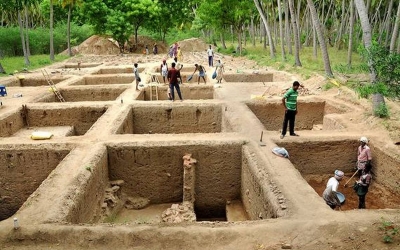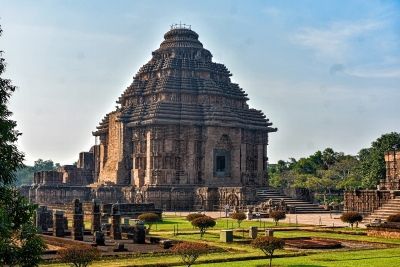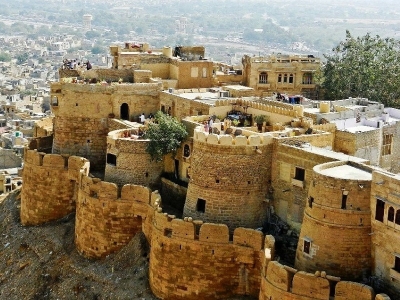
Excavations at Keezhadi an archaeological site in Sivaganga district near Madurai. Tamil Nadu, have brought to light significant details about the Sangam era. The sixth phase of the excavation came to an end late September. However, only one report that of the fourth phase) has been published so far. The first three phases were conducted by the Archaeological Survey of India (ASI) and the latest three were under the ambit of the The Tamil Nadu Archaeology Department (TNAD). While avaiting the reports of the fifth and sixth phases, political parties in Tamil Nadu have urged the ASI to publish the findings of the first three phases of excavation without delay Meanwhile, scientists have discovered the oldest known human-made nanomaterials in the "unique black coatings" of potsherds - dated to 600 BC - unearthed from Keezhadi. (Nanomaterials are materials with at least one dimension measuring 100 nm or less. A nanometre (nm) is one millionth of a millimetre. Nanomaterials can occur naturally, created as the byproducts of combustion reactions, or be produced purposefully through engineering. Nanomaterials may be added to materials such as cement or cloth to make them stronger and yet lighter.)
Let's take a look at how Keezhadi has helped us understand the cultural history of the Sangam era.
How were the excavations carried out?
In 2013-2014, the ASI began exploration in Tamil Nadu, along the banks of the river Vaigai. More than 290 sites were identified in Theni, Dindigul, Madurai, Sivaganga and Ramanathapuram districts for excavation. Keezhadi, a village 12 km southeast of Madurai in Sivaganga district, was one of them. In Keezhadi, the first phase of excavation began in 2015. The site began yielding rich artefacts such as potsherds with Tamil-Brahmi inscriptions, deep terracotta ring wells, big storage pots, pots with spouts, decorated pots, and beads made of semiprecious stones. Further excavations at the Pallichanthai Thidal in Keezhadi pointed to an ancient civilisation that thrived on the banks of the Vaigai.
What are some of the major findings from the site?
• The Sangam era could be 300 years older than thought. Cultural deposits unearthed date back to a period between the 6th Century BCE and the 1st Century CE.
• The Keezhadi site provides overwhelming evidence of the presence of an urban settlement. The artefacts suggest that urbanisation took place on the Vaigai plains in Tamil Nadu around the 6th century BCE, making it contemporary to the Gangetic plain civilisation The discovery of brick structures with classical features such as platforms, ring wells, rectangular tanks, square tanks with extended structures, and channels vouches for the presence of an urban culture there.
• Sangam people may have participated in recreational activities - as many dice made of ivory have been unearthed.
• The Keezhadi findings push back the date of the Tamil-Brahmi script to another century, i.e.. 6th century BCE. • Many Tamil-Brahmi inscribed potsherds have been recovered, suggesting that the residents of the Sangam era attained literacy or learned the art of writing as early as the 6th century BCE.
• There are also other markings alongside the Tamil-Brahmi symbols which apparently suggest a connection with the Indus Valley civilisation. Artefacts with 'graffiti' or markings establish a possible link between the scripts of the Indus Valley Civilisation and Tamil Brahmi which is the precursor to modem Tamil.
• Skeletal fragments of animals suggest that animals were used predominantly for agricultural purposes.
• Pottery specimens confirm that water containers and cooking vessels were shaped out of locally available materials.
What is the Sangam era?
The Sangam period refers to a period in the history of ancient Tamil Nadu. Kerala the souther parts of Kanataka and Andhra Pradesh, and northern Sri Lanka. The TNAD has stated that the cultural deposits unearthed indicate that the era could be safely dated to a period between the 6th century BCE and the 1st century CE. It is known for scholarly congregations in and around the city of Madurai. The period is considered the golden age of Tamil literature and culture as many of its epics were composed during this time.
Why are the Sangam era people believed to have been well-versed in city planning?
The fourth phase report highlighted the supposedly high standard of living in the Sangam era. It talked about the excavation having unearthed well-laid floors made of fine clay along with roof tiles. The finger groove impressions on roof indicate they may have been used to drain water. Other excavations include terracotta pipes that could have been used for carrying protected water. Another brick structure, which looked like a tank/trough, haul an inlet and an outlet A covered drain was found below this. A small structure with a stone slab on top, perhaps meant for washing dothes, was also one of the artefacts Excavated.
Different types of water channels brick construction evidence of trade relations with other domestic and foreign places sign and letter usages revealed that the civilisation along the Vaigai river was advanced.
What is the possible connection between the Indus script and the Tamil-Brahmi script?
The Indus Valley Civilisation existed between 5000 BCE and 1500 BCE in the northwestern part of India. When it declined, its people started moving towards east and south. The script that was used by the people of this civilisation has been termed the Indus script.
Now, the 'graffiti marks on the artefacts obtained from the Keezhadi excavation site point to a link between the scripts of the Indus Valley Civilisation and Tamil Brahmi which is the precursor to modem Tamil. According to the report: One kind of script that survived in the time period between the disappearance of the Indus script and the emergence of the Brahmi script has been referred to as graffti by the scholars. These marks they believe have evolved or transformed from the Indus script and served as the precursor to the Brahmi script.
Therefore, these graffiti cannot be dismissed as mere scratches. Besides, like the Indus script this also could not be deciphered till date. Among the scripts of India, the Indus script is considered to be the earliest. After the decline of the script and before the emergence of the Brahmi script there seemed to be a gap. Researchers note that this graffti could fill that gap.
What do we know about the discovery of nanomaterials?
Scientists have discovered the oldest known human made nanomaterials in the unique black coatings of potsherds from Keezhadi. Research revealed that these coatings are made of carbon nanotubes (CNTS) which have enabled the layer to last more than 2,600 years, raising questions on the tools used during those periods to achieve high temperatures for making earthenwares.
Scientists say that the people of this time may not have intentionally added CNTS. instead, during the processing at high temperatures these would have just formed accidentally. They may have added or coated something similar to plant-sap to the inside of the pots, and subject it to the nearly 1100-1400 degree Celsius high-temperature fire treatment as seen in kilns. This fire treatment may have led to the formation of CNTS during high-temperature processing, which has likely strengthened the pot and made the coating durable.
Picture Credit : Google


